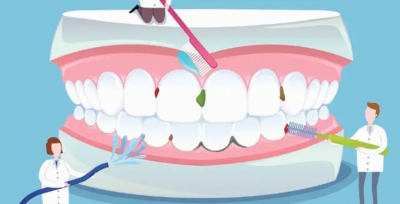Everyone knows that brushing your teeth is a basic step in maintaining oral health, but have you really mastered the proper way to brush your teeth? Do you simply grab a toothbrush and brush it quickly? Brushing isn't just about getting rid of food debris; brushing incorrectly can even exacerbate oral problems, such as bleeding gums, worn enamel, and even cavities.
Today, we are going to talk about how to brush your teeth properly, so that your smile is brighter and your mouth is healthier! It's not just about whitening your teeth or freshening your breath. There are more health secrets behind brushing your teeth.
Why is brushing your teeth so important?
Brushing your teeth isn't just about making your teeth look whiter and your smile more attractive, it's directly related to your overall health. Plaque in the mouth is the culprit that leads to tooth decay and gum disease, if not removed in time, they will form a layer of adhesive biofilm on the surface of the teeth, bacteria in this film, resulting in tooth corrosion and inflammation, and over time, teeth will even fall out.
Not only that, studies have shown that if gingivitis, periodontal disease and other problems are not dealt with in time, they may even increase the risk of systemic diseases such as heart disease and diabetes. Hearing this, did you pay more attention to brushing your teeth? But the problem comes, brushing is not just a brush can be solved, how to brush properly, is the key.

1. Choose the right toothbrush and toothpaste
The first step in brushing your teeth is actually choosing the right tools. Many people may ignore this point, thinking that any toothbrush can do the cleaning effect. In fact, choosing a good toothbrush can make you get twice the result with half the effort.
1.1 Choice of toothbrush
Soft bristles: Choose soft bristles, especially nylon soft bristles. Hard bristles, while seemingly cleaner, can actually overstimulate the gums and even damage tooth enamel. A soft-bristled toothbrush can effectively remove plaque and dirt while avoiding damage to your teeth and gums.
Electric vs. Manual toothbrushes: Electric toothbrushes provide continuous vibration to help clean, and many people use electric toothbrushes to brush more cleanfully, while also reducing the force of brushing, but that doesn't mean manual toothbrushes are bad. As long as you have the right brushing method, manual toothbrushes can also clean very thoroughly. For people who are too lazy to brush their teeth, an electric toothbrush may be a good choice, which will remind you of the time and intensity of brushing and help you develop good brushing habits.
1.2 Choice of toothpaste
Fluoride toothpaste is the best choice for brushing teeth. Fluoride helps strengthen tooth enamel and prevent tooth decay. There are also toothpaste on the market for a variety of oral problems, such as whitening, anti-allergy, gum care, etc. Choose the right toothpaste according to your personal needs. However, remember to control the amount of toothpaste, a pea-sized bit is enough, too much can lead to excessive foam toothpaste, affect brushing time, and even accidentally swallow toothpaste.
2. Master proper brushing techniques
Just because you choose the right toothbrush and toothpaste does not mean you will clean your teeth perfectly. How you brush your teeth is also crucial. When many people brush their teeth, they habitually brush horizontally, or brush casually. In fact, the right way to brush your teeth will let you get twice the result with half the effort, the cleaning effect is better, but also to avoid unnecessary dental problems.
2.1 Angle and action of brushing teeth
Bristle Angle: Placing the toothbrush between the gum line and the teeth at a 45-degree Angle allows the bristles to better clean into the dead corner of the gum line. If the toothbrush is parallel to the gum line, you may miss the plaque near the gum line.
Circle action: Avoid horizontal brushing, which not only can not thoroughly clean the teeth, but will damage the tooth enamel. Instead, brush each tooth in a gentle circular motion to ensure that every corner is covered.
2.2 Time to brush teeth
Experts recommend that you brush your teeth for at least two minutes each time. Many people brush very quickly, thinking that 5 seconds is enough, which is obviously not enough. You can divide the mouth into four parts, upper left, upper right, lower left, and lower right, and brush each part for 30 seconds. To make sure you don't miss anything, sing a song while brushing your teeth, wait until the song is over, and then switch sides to brush your teeth, both to ensure time and to make brushing more fun.
2.3 Order of brushing teeth
Start from the outer side of the upper row, brush to the outer side of the lower row, then the inner side, and finally the chewing surface, especially the back molars.
When brushing the inside of each tooth, tilt the toothbrush so that the tip reaches the gum line to ensure that the inside of each tooth is thoroughly cleaned.
3. Floss and mouthwash: Perfect for brushing
Brushing your teeth is only part of cleaning your mouth. Floss and mouthwash can help you clean more thoroughly and avoid areas that are hard to reach. Floss removes plaque, bacteria and food debris from between your teeth, which is often difficult to reach with a regular toothbrush. Fluoride mouthwash can further prevent tooth decay and gum disease and help reduce inflammation and bacteria in the mouth. However, mouthwash can only be used as an aid, not a complete replacement for brushing teeth. When choosing a mouthwash, it is best to choose products that contain fluorine or are antibacterial.
The correct way to brush your teeth may seem simple, but there are actually many details that deserve our attention. Choosing the right toothbrush, using the right brushing techniques, mixing floss and mouthwash properly, changing your toothbrush regularly and checking your oral health can really protect our teeth.


_20241106154012A037.jpg)